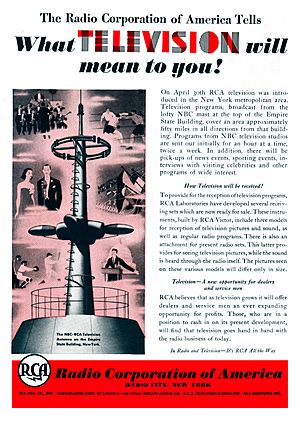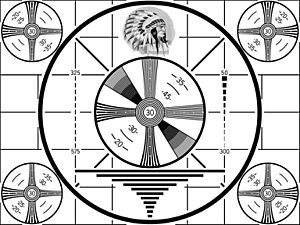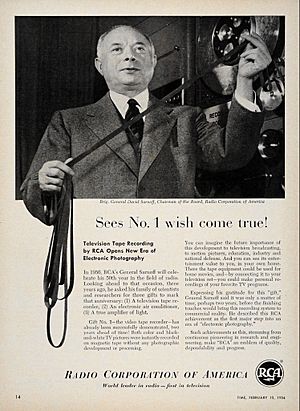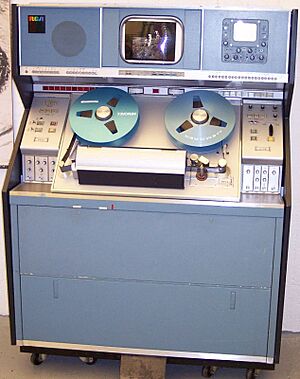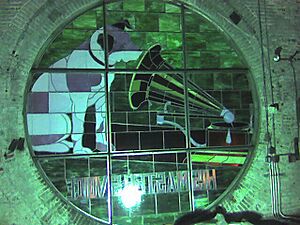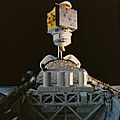RCA facts for kids
 |
|
| Founded | 1919 |
|---|---|
| Defunct | 1986 |
| Headquarters | New York City, New York, United States |
|
Key people
|
David Sarnoff, first general manager |
| Products | RCA Photophone Electric Phonograph Videodisc RCA Televisions RCA Studio II |
| Divisions | NBC |
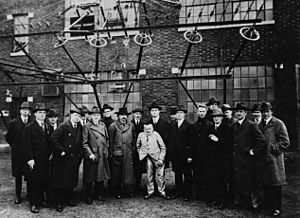
RCA Corporation, originally known as the Radio Corporation of America, was an American electronics company. It existed from 1919 until 1986. General Electric took over the company in 1985 and then split it up.
Today, the RCA brand name is still used by companies like Sony Music Entertainment and Technicolor. They allow other companies, such as Audiovox and TCL Corporation, to use the name for products that come from RCA's original ideas.
Contents
How RCA Started
The Idea from General Electric
After World War I began in 1914, radio messages across the Atlantic Ocean became very important. The Allies (countries fighting Germany) cut Germany's underwater telegraph cables. This meant Germany and its allies had to rely on long-distance radio communication to talk to neutral countries in the Americas.
In 1917, the U.S. government took control of all radio patents. This was to help with the war effort. All radio equipment was made for the U.S. Army, U.S. Navy, and other military branches. The government wanted to keep control over all radio technology. This control ended in late 1918 when a bill to continue it did not pass. The war also ended that November.
Even though the government's control ended, the Army and Navy still wanted a national radio system for the U.S. In April 1919, naval leaders met with executives from General Electric Corporation (GE). They asked GE to stop selling its powerful radio transmitters to the British-owned Marconi Company.
The government suggested that if GE created an American-owned radio company, the Army and Navy would help this new company control long-distance radio communication. This led to GE buying the American Marconi company. They then created the Radio Corporation of America.
RCA is Formed

General Electric officially formed the Radio Corporation of America on October 17, 1919. GE owned most of the company. RCA was created from parts of the Marconi Wireless Telegraph Company of America (including David Sarnoff), the Pan-American Telegraph Company, and assets the United States Navy already controlled.
RCA worked with GE, the United Fruit Company, Westinghouse Electric Corporation, and American Telephone & Telegraph (AT&T). This teamwork led to new ideas in powerful radio technology. It also led to the creation of the National Broadcasting Company (NBC) in the U.S. The Army and Navy gave RCA the radio terminals that had been taken from American Marconi during the war.
At first, the government argued that there were only a few usable radio frequencies. They said these needed to be claimed by the U.S. before other countries did. However, this idea changed in the mid-1920s. People discovered that shortwave radio (radio waves that travel very far) could be used for long-range communication.
The first leader of RCA was Owen D. Young. David Sarnoff became its general manager. RCA's rules said that most of its stock had to be owned by American citizens. RCA agreed to sell radio equipment made by GE and Westinghouse. Over time, RCA also got many radio patents from Westinghouse and the United Fruit Company. RCA later gained many more patents, including the important superheterodyne receiver invented by Edwin Armstrong.
For many years, RCA continued to offer international communication services through its special divisions.
Growing into Broadcasting
By 1926, the market for commercial radio was growing. RCA bought the WEAF and WCAP radio stations and networks from AT&T. They combined these with their own WJZ and WRC stations. This led to the creation of the National Broadcasting Company (NBC).
Radio and Music
From 1919 to 1930, GE used RCA to sell its radios. Westinghouse also sold home radios through RCA during this time.
Phonographs and Records
In 1929, RCA bought the Victor Talking Machine Company. Victor was the world's largest maker of phonographs (like the famous "Victrola") and records. This purchase also gave RCA a majority share in the Victor Company of Japan (JVC). The new company became RCA-Victor. With Victor, RCA gained the rights to the Nipper dog trademark in the Americas.
RCA Victor made many radio-phonographs. They also created RCA Photophone, a system that put sound directly onto film for movies. This competed with other sound systems of the time.
In 1930, RCA started selling the first electronic turntable. In 1931, RCA Victor began selling 33⅓ rpm records. These records were not very successful at first. They were expensive, and the sound quality wasn't great. The system was stopped after about a year.
In 1930, RCA agreed to move into a new, large building in Rockefeller Center in New York City. This building, at 30 Rockefeller Plaza, became known as the RCA building in 1933. It is now called the GE Building. This agreement was very important for the Rockefeller Center project to be built.
In 1932, RCA introduced the Duo Jr. turntable, which could be plugged into radios.
RCA Becomes Independent
In 1930, the U.S. Department of Justice filed antitrust charges against RCA, General Electric, and Westinghouse. This meant the government thought they were unfairly controlling the market. As a result, GE and Westinghouse had to give up their ownership in RCA. RCA was allowed to keep its radio factories. GE and Westinghouse could compete in the radio business after 30 months.
Television and Beyond
Early Electronic Television
RCA showed off its electronic television system at the 1939 New York World's Fair. They also created the first television test pattern in the USA. RCA began regular experimental TV broadcasts from NBC studios in New York City on April 30, 1939. This was through station W2XBS (which later became WNBC channel 4) from a transmitter on top of The Empire State Building. At the same time, RCA started selling its first television sets in New York stores.
When the NTSC standard was approved, the Federal Communications Commission allowed commercial television to start on July 1, 1941. World War II slowed down the spread of television in the U.S. However, RCA began selling TV sets again almost right after the war ended. During the war, RCA also worked on radar and radio for the war effort. This helped RCA a lot with its television research.
RCA was a major maker of vacuum tubes (called Radiotron) in the U.S. They made many new products, from metal tubes to the tiny Nuvistor tubes used in TV sets. These Nuvistor tubes were a last effort for vacuum tubes to compete with the new transistors. RCA was so powerful in the market that they set the prices for vacuum tubes in the U.S. By 1975, the company had switched almost entirely to solid-state parts in their TVs, except for the main cathode ray tube(CRT) screen.
Because of antitrust concerns, the FCC forced NBC's radio networks to split up. This was confirmed by the U.S. Supreme Court. On October 12, 1943, the "NBC Blue" radio network was sold and renamed "The Blue Network, Inc." It later became the American Broadcasting Company (ABC) in 1946. The "NBC Red" network kept the NBC name, and RCA still owned it.
New Directions
In 1941, a new research and development center, RCA Laboratories, was started in Princeton, New Jersey. This lab developed many new things, such as color television, the electron microscope, CMOS technology (used in computer chips), liquid crystal displays (LCDs), videocassette recorders, and high-definition television.
During and after World War II, RCA created several new divisions. These focused on defense, space exploration, and other areas. RCA units won five awards for excellence in wartime production. Also during the war, RCA and JVC (Victor Company of Japan) became separate companies.
In 1949, RCA Victor released the first 45 rpm record. This was to compete with CBS/Columbia's 33⅓ rpm "LP" format. RCA's own 33⅓ rpm "LP" records came out in 1950.
In 1953, RCA's all-electronic color TV technology became the standard for American color TV. It's now known as NTSC. RCA cameras and studio equipment became standard in many American TV stations. RCA CT-100 television sets introduced color TV to the public.
In 1955, RCA sold its large appliance business to Whirlpool Corporation. As part of the deal, Whirlpool could sell "RCA Whirlpool" appliances for a time.
RCA was one of several major computer companies in the 1960s, competing with IBM and others. RCA made the Spectra 70 Series computers, which were similar to IBM's System/360. RCA stopped making computers in 1971.
RCA was a big supporter of the eight-track tape cartridge, which it launched in 1965. Eight-track tapes were very popular and profitable at first. However, sales soon dropped as people started to prefer the smaller cassette tape format developed by Philips.
Later Years and End
David Sarnoff, who had helped RCA become a huge company, handed control to his son Robert in 1970. David passed away the next year.
In 1971, RCA announced it would stop making general-purpose computer systems. This showed RCA was moving away from just electronics and into many different businesses. IBM's new computers meant RCA would need to invest a lot more money in its computer division, and the company decided not to.
In the late 1960s and 1970s, RCA Corporation (its new formal name) bought many other types of companies. Under Robert Sarnoff, RCA bought Hertz (rental cars), Banquet (frozen foods), Coronet (carpeting), Random House (publishing), and Gibson (greeting cards). People joked about this, calling the company "Rugs Chickens & Automobiles."
Robert Sarnoff was removed from his position in 1975. The company then faced financial problems. RCA still made excellent broadcast and satellite communication equipment, but its NBC radio and television networks declined.
Around 1980, RCA decided to move its TV manufacturing to Mexico. RCA was still making money in 1983. However, new consumer electronics products, like the SelectaVision videodisc system, lost money. This system couldn't compete with cheaper, recordable videotape technology. RCA stopped making videodiscs in 1985, losing hundreds of millions of dollars.
In 1984, the RCA Broadcast Systems Division moved. Many of the original RCA Victor buildings in Camden, New Jersey, were torn down, except for a few historic ones.
Taken Over by GE
RCA's financial situation led to General Electric taking it over in 1986. GE then broke up the company. GE sold its share in RCA/Ariola International Records to its partner Bertelsmann. The company was renamed BMG Music.
In 1988, GE sold the rights to make RCA- and GE-branded televisions and other electronics to the French company Thomson Consumer Electronics.
RCA Laboratories became the David Sarnoff Research Center under SRI International. GE funded the lab for a few years, then the lab had to find its own research contracts.
GE sold the NBC Radio Network and all its radio stations. In 2011, GE sold most of its share in National Broadcasting Company (which was part of NBC Universal) to Comcast. By 2013, Comcast owned all of NBC Universal.
The only part of RCA that GE still owns today is its Government Services unit. For more information on the RCA brand after 1986, see RCA (trademark).
RCA's Lasting Impact
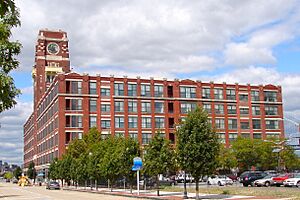
Old RCA radios and early color television sets are highly sought after by collectors. This is because of their popularity during the "golden age of radio," their high quality, new engineering ideas, cool designs, and the famous RCA name. The pre-war television sets from 1939, like the TRK-5, TRK-9, and TRK-12 models, are especially valuable to collectors.
The historic RCA Victor Building 17, also known as the "Nipper Building", in Camden, New Jersey, was turned into luxury apartments in 2003.
Environmental Concerns
A former RCA factory in Taiwan polluted groundwater with harmful chemicals. This led to a higher number of cancer cases among former employees. The area was declared a toxic site. Both GE and Thomson spent millions of dollars to clean it up.
A plant in Lancaster, Pennsylvania, that RCA ran from the 1940s to 1986, released a lot of pollutants into the air each year. The United States Environmental Protection Agency (EPA) found that the groundwater at the site was contaminated.
Another site in Mountaintop, Pennsylvania, which RCA operated in the 1960s, also had high levels of harmful chemicals in its groundwater.
A site in Burlington, Massachusetts, used by RCA from 1958 to 1994 to make military electronics, created hazardous waste.
In Barceloneta, Puerto Rico, an RCA plant produced waste containing chemicals like chromium and selenium. Chemical waste was stored in lagoons that drained into the groundwater.
History Summary
After World War I started in 1914, the Allies cut Germany's transatlantic telegraph cables. This greatly increased radio traffic across the Atlantic Ocean. The General Electric corporation bought shares of the Marconi Wireless Telegraph Company of America in 1919. With this, they formed the Radio Corporation of America (RCA). After the "golden age" of Radio ended, RCA began to decline. Finally, in 1986, General Electric bought back RCA, along with NBC, for $6.28 million.
Images for kids
-
An illustration of how a fully built RCA Radio Central facility in Rocky Point, Long Island, New York, might have looked. Only a small part was actually built.
See also
 In Spanish: Radio Corporation of America para niños
In Spanish: Radio Corporation of America para niños



